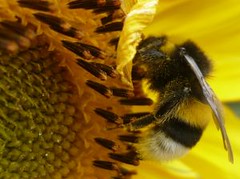Article written by J. E. Davidson
Bee Venom Therapy history

Bee sting therapy, also known as bee venom therapy (BVT) is an alternative medicine that has been around for thousands of years. The ancient Greeks, Egyptians, and Chinese practiced apitherapy, which includes the use of beehive products such as honey, pollen, royal jelly and propolis, as well as bee venom, in the treatment of diseases. Ancient apitherapists treated arthritis, rheumatism, back pain and skin diseases. Modern practice also includes treatment for multiple sclerosis, Lyme disease, tendinitis, rheumatoid arthritis, fibromyositis and chronic fatigue syndrome.
Traditionally, live honeybees were allowed to sting the body, either at the affected area, trigger points, or acupuncture points. The practitioner will hold the bee next to the skin with tweezers and stimulate it to sting the patient. Solutions may also be made from the bee venom and injected under the skin to mimic a bee sting. The injectable form is considered a homeopathic preparation. Depending upon the nature of the disease, creams or liniments containing beehive products might be applied to the skin.
Honeybee venom contains active compounds with pharmaceutical properties. Melittin activates the adrenal glands, which stimulate the bodyÃs immune system and natural healing response. It is said to be 100 times more effective than hydrocortisone. Adolapin has pain-killing properties. BVT may boost energy levels and create a feeling of well-being in the patient.
Should I try Bee Venom Therapy on myself?
Bee Venom Therapy can be administered by apitherapists, beekeepers, or acupuncturists. It is unwise for the untrained to practice this therapy on themselves or others, since certain guidelines must be followed. The therapist must first determine whether the patient is allergic to bee venom, usually with a test sting on the knee or forearm. A small percentage, about 2%, of the population may have a severe allergic reaction to a bee sting which results in anaphylactic shock, a medical emergency. Medicines should be kept on hand to counteract an allergic reaction.
Many people are sensitive to bee stings but can gradually be desensitized. The venom is given in one or two injections or stings three times a week and increased gradually. The duration of the treatment is determined by the nature and severity of the condition being treated. Some BVT can involve up to 80 or more stings per day. Even a person who has never had a severe allergic reaction to be stings may develop one with the next sting, and the patient and therapist must be prepared for such an event with each treatment.
Bee stings result in a red, swollen, and itchy bump. This reaction is seen as an indication that the patient is responding to the venom for effective therapy. The discomfort usually lasts for only a few minutes and can be relieved by blowing a fan across the area or applying a hot compress.
There is no scientific evidence that BVT works, although studies involving BVT and knee osteoarthritis have begun at the Rheumatology Therapeutics Medical Center. The study is currently recruiting volunteers for Phase III through the public database at the ClinicalTrials.gov website.
There is anecdotal evidence that BVT works for some patients. It may be that the results are related to the acupuncture effect. Patients with multiple sclerosis have reported dramatic improvements in vision, mobility, coordination, and sensitivity to touch. MS victims are often faced with a lifetime of taking medications that often have little effect while their physical condition worsens. Under the care of a licensed practitioner and the supervision of an allergist, BVT can be safely used when traditional methods of treatment fail.
This article is not meant to replace professional medical advice. Always consult with your primary care physician before beginning any type of alternative therapy.










Speak Your Mind